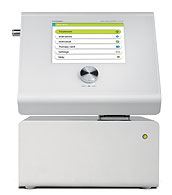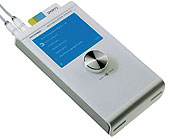Report On The Treatment Method DEEP OSCILLATION® In The Diagnosis of Acute Shin Splints
Background: Very active footballer, mother of two and also a neighbour of Physiotherapist Alex Weiss, asked for his quick therapeutic help to make a speedy recovery. The lady was loaned the DEEP OSCILLATION Evident device for 4 days and self treated, two to three times a day.
Read on PressReleasePoint 30.09.2014

Report from Clinician: Dipl. Physiotherapist Alexander Weiss, offered the loan of the [[$DOE]] for self-treatment of acute shin splints, the [[$dops]] was purchased for home use after the loan ended such were the results achieved.
Devices:


The [[$DOE} was used in this instance but it could just as easily have been a [[$DOPS]], program ‘haematoma’, treatment time 20 minutes, with hand applicator and large head 9mm, 3 frequency ranges
Result:
Very good pain relief and improved movement restrictions by Monday evening. Likewise, her husband gave a very positive feedback about his treatment on a painful elbow (which I didn't know about until later). Since this very brief, but very successful test phase, this neighbour has immediately become an enthusiastic user of [[$do]] and has recommended it to her other football team colleagues. Also she purchased a DO PERSONAL device with Sports card that same Monday evening, and treats herself on a regular basis.
-
[[!Rowboat?
&table=`modx_maxigallery`
&tpl=`maxgalTpl`
&limit=`0`
&where=`{"gal_id:=":985}`
&sortBy=`pos`
&toPlaceholder=`xrow`
]]
[[+xrow]]
Report On The Treatment Method DEEP OSCILLATION® In The Diagnosis of Acute Shin Splints
Background: Very active footballer, mother of two and also a neighbour of Physiotherapist Alex Weiss, asked for his quick therapeutic help to make a speedy recovery. The lady was loaned the DEEP OSCILLATION Evident device for 4 days and self treated, two to three times a day.
Read on PressReleasePoint 30.09.2014

Report from Clinician: Dipl. Physiotherapist Alexander Weiss, offered the loan of the [[$DOE]] for self-treatment of acute shin splints, the [[$dops]] was purchased for home use after the loan ended such were the results achieved.
Devices:


The [[$DOE} was used in this instance but it could just as easily have been a [[$DOPS]], program ‘haematoma’, treatment time 20 minutes, with hand applicator and large head 9mm, 3 frequency ranges
Result:
Very good pain relief and improved movement restrictions by Monday evening. Likewise, her husband gave a very positive feedback about his treatment on a painful elbow (which I didn't know about until later). Since this very brief, but very successful test phase, this neighbour has immediately become an enthusiastic user of [[$do]] and has recommended it to her other football team colleagues. Also she purchased a DO PERSONAL device with Sports card that same Monday evening, and treats herself on a regular basis.
